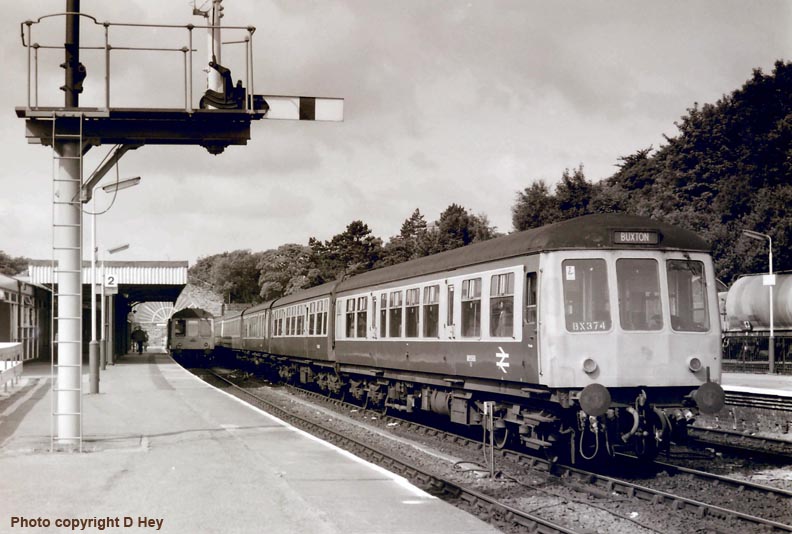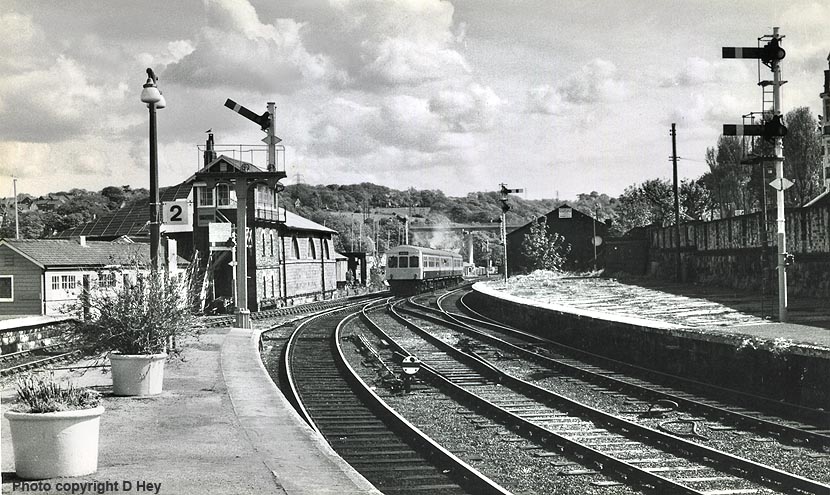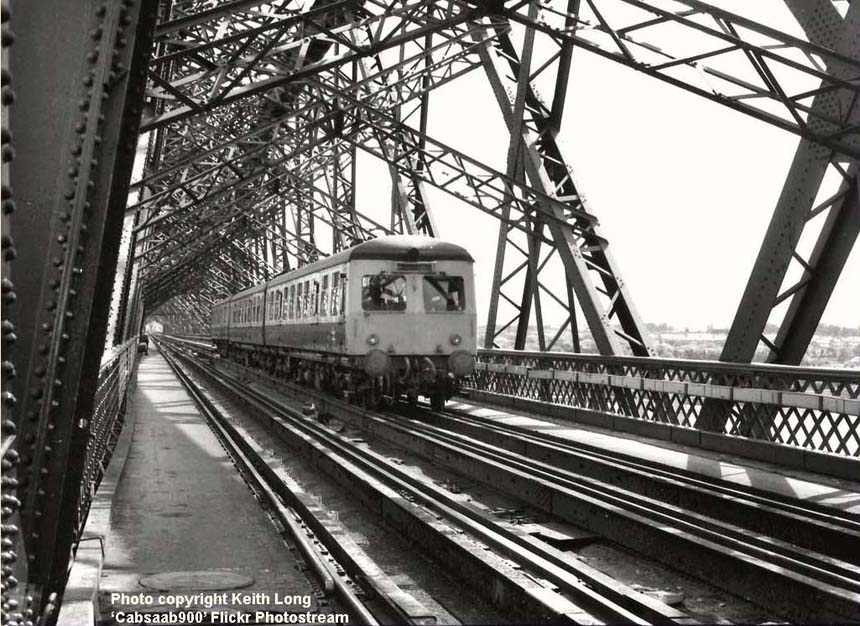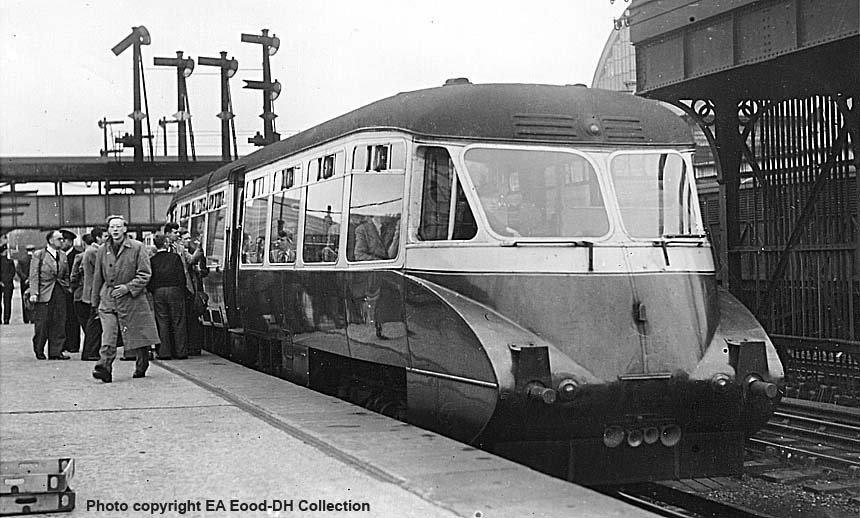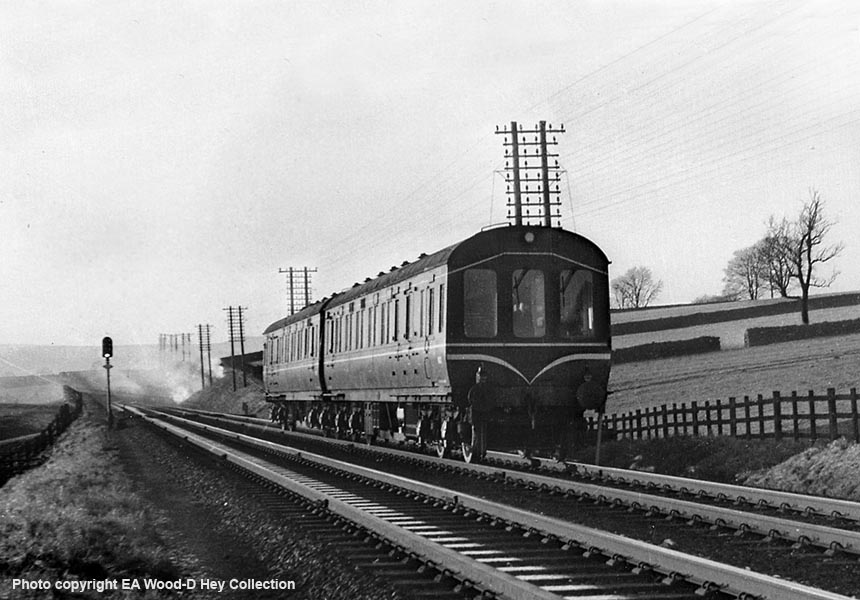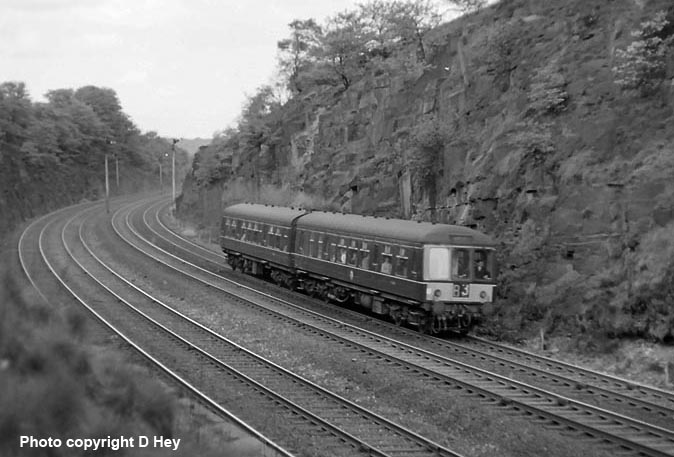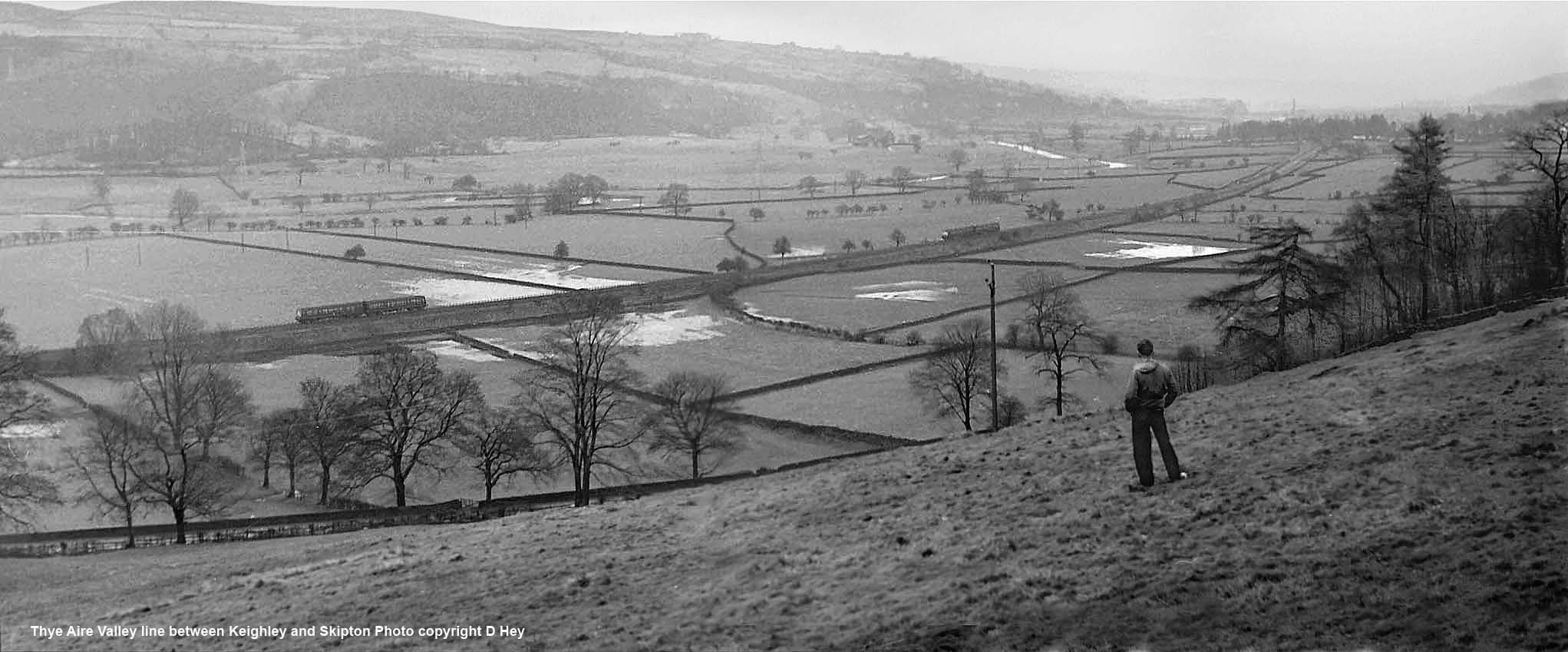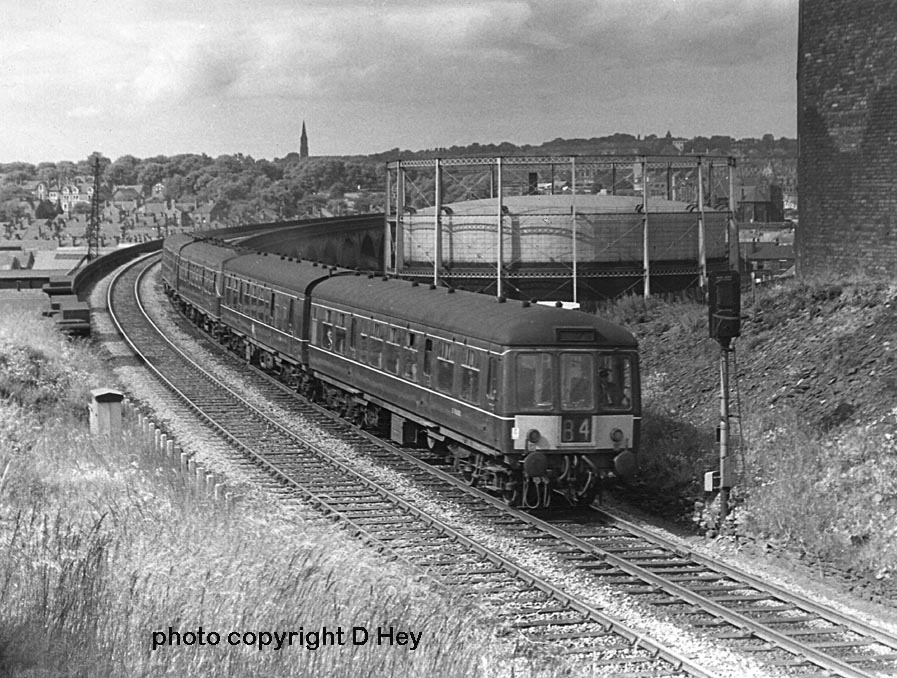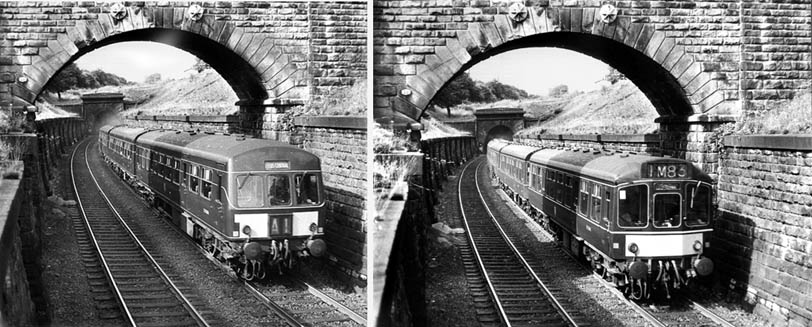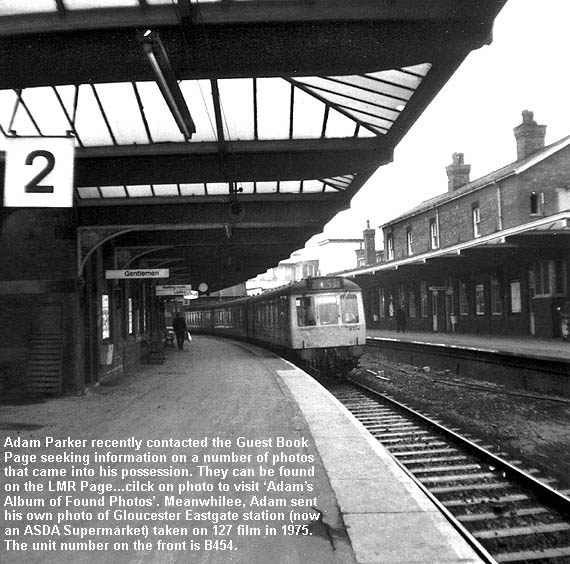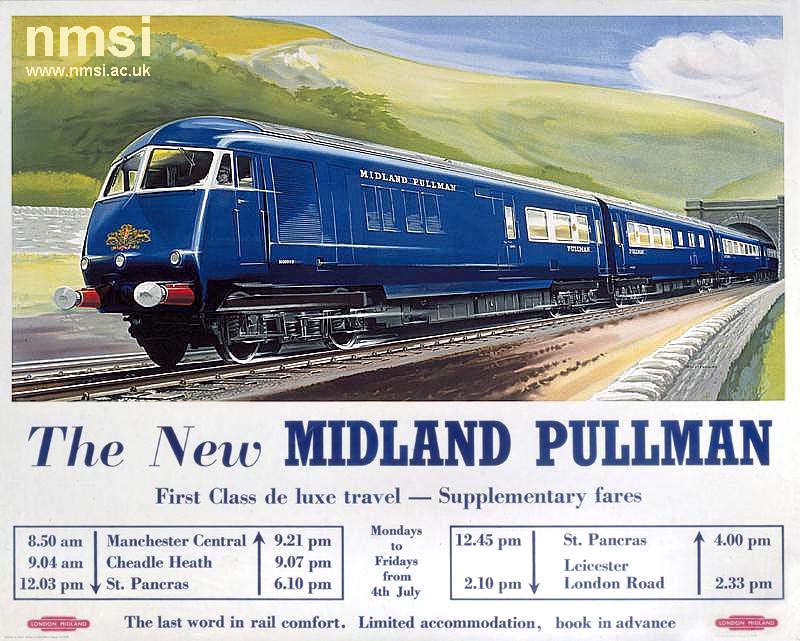The steam-powered forerunners of today's diesel railcar were introduced at the start of the 20th Century, made up of a conventional steam locomotive either articulated to the coach body or built into it. By the late 1920s many were powered by a high-speed engines, such as the Sentinel and Clayton types, taking steam from a high-pressure water-tube boiler. The L & Y, GWR and LNER were major customers. The LNER had 90 railcars, all liveried green and white, each bearing racy stage-coach names. Similarly proportioned is this early Armstrong Whitworth diesel railcar No 25 Tyneside Venturer, seen at Newcastle Central in August 1932. Photo © K Todd.
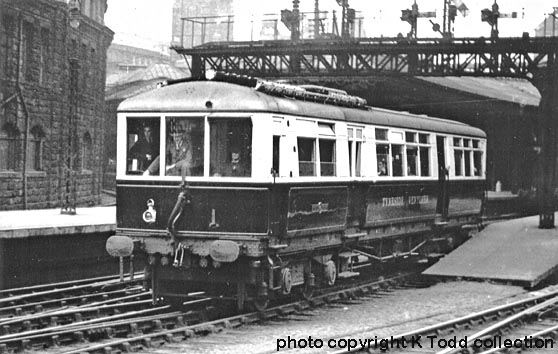
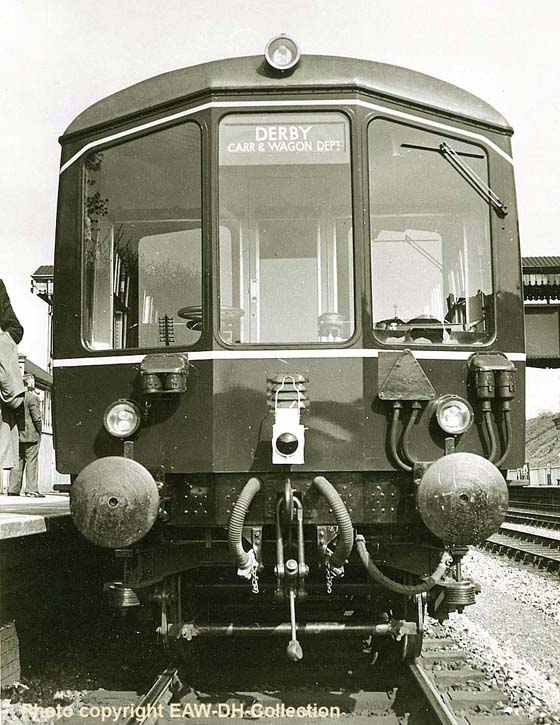
Love them or hate them, the dmu is an integral part of today's rail network. The first tangible evidence of sweeping change came on my local line in April of 1954 when the Ministry of Transport gave British Railways (North Eastern Region) approval for the introduction of eight 2-car diesel railcar units on the rail service between Leeds Central, Harrogate and Bradford Exchange.
The response by the travelling public was unanimously favourable, though this is hardly surprising since many local trains were made up of non-corridor passenger stock and headed by a dirty GNR Class N1 0-6-2T or Class J50 0-6-0T based at Copley Hill, neither of which could measure up to the high standard of performances set by the new diesel railcars.
Truth is, the dmu may well have satisfied those rail travellers not enamoured with old-fashioned steam trains, but they had no a place in the hearts of diehard train spotters. Or had they?
I suppose one can be accused of looking back through rose-tinted spectacles at the halcyon days of train spotting in the Fifties, but the fact is it was a good time to be a small boy; indeed the overall scenario must rely on the testimony of those who were there, and contrary to popular belief, a lot of spotters had a sneaking fondness for the new railcars, but steadfastly refused to admit it. Let's fact it, if they were seen to be betraying the brotherhood's allegiance to steam it would have been construed as jumping ship and joining the other side.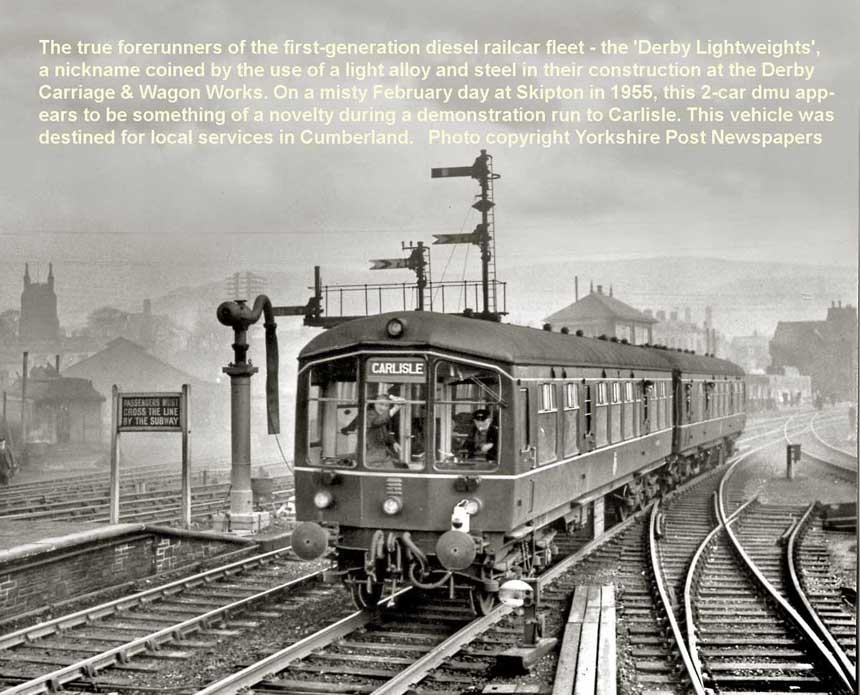
TRANSITION FROM STEAM - WHITBY, NORTH YORKSHIRE
Attitudes change as we grow older and nostalgia becomes embedded in everyone's consciousness. Nowadays our old photos of green-liveried dmus (with straw lining and 'speed whiskers') revive memories of family holidays to Scarborough on the Yorkshire coast during the late 1950s. The most enjoyable part of the week was taking a round-trip excursion by dmu to Whitby via Malton and Pickering, returning along the scenic coastal route via Robin Hood's Bay, which involved a 3-mile climb at 1 in 39 from Robin Hood's Bay to the summit at Ravenscar.
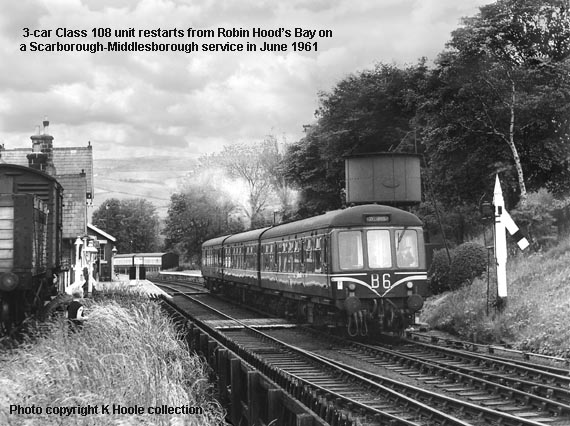
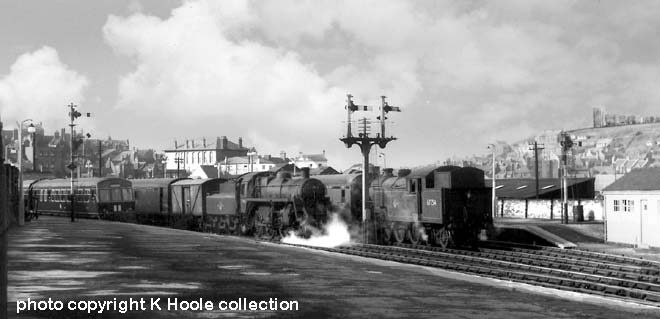
(Above) The Yorkshire coastal town of Whitby lies deep in ex-North Eastern Railway territory. The new Metro-Cammell dmus arrived in 1958, but despite the increase in passengers and improved economies, out of the four routes that converged on the town only the Esk Valley line now survives. The Whitby-Loftus line was closed in 1958, followed seven years later by the withdrawal of the scenic coastal route to Scarborough and the line to York via Pickering. In this view, Whitby Town station is host to three generations of motive power, the oldest being the Thompson Class 'L1' 2-6-4T No 67754, one of 99 engines Nos 67701-67800 introduced to traffic from 1945 to 1950. In the centre, a Swindon-built 'BR3' mixed traffic 2-6-0 No 77012 awaits departure with a branch goods train for York, and on the left a Metro-Cammell dmu forms a Whitby-Middlesborough service via the Esk Valley. Photo © K Hoole collection
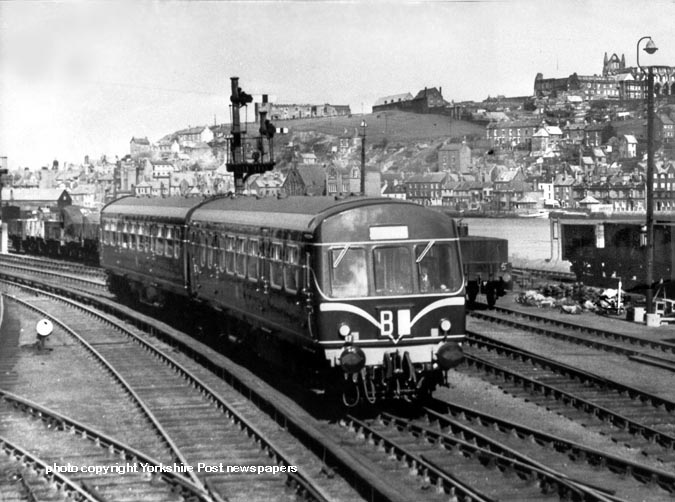
(Above-Below) As a textbook exercise in turning a problem into a major disaster, the Government's handling of the Beeching Plan takes some beating. There are no short cuts, except to the wrong answers, and BR certainly found a few. Indeed, much of the blame lies at the door of the Government for rushing into closures too fast, because had Beeching's original plan for axing 5,000 route miles of track and 2,363 stations been handled with less haste, then many sizeable towns would still be linked to the rail network today. But then, if one accepts the figures quoted for the maintenance of some lines, BR made a plausible case for closure, and in many ways it is surprising that some branch line traffic survived as long as they did. For example, if we fast forward 40-odd years, it is hard to believe that a busy route like the former Great Central main line between London and Sheffield should be axed, yet the lightly-used Esk Valley line was granted a stay of execution. The scenic route was reprieved when the Government decided the line provided a vital link for the isolated villages in some of the remotest parts of the North Yorkshire Moors. This brand new 2-car Metro-Cammel unit departs from Whitby on a demonstration run prior to commencement of the new dmu service. (Below) A 3-car Metro-Cammell heads out from Whitby on the Esk Valley line in July 1983. Photos © Yorkshire Post Newspapers Ltd, D Hey. Footnote: My thanks to Roy Lambeth for pointing me in the direction of the Yorkshire Film Archive Online, which features a journey by dmu in a film - 'A sentimental journey Whitby-Scarborough' - made by railway enthusiast and filmmaker Frank Dean in 1966...link here
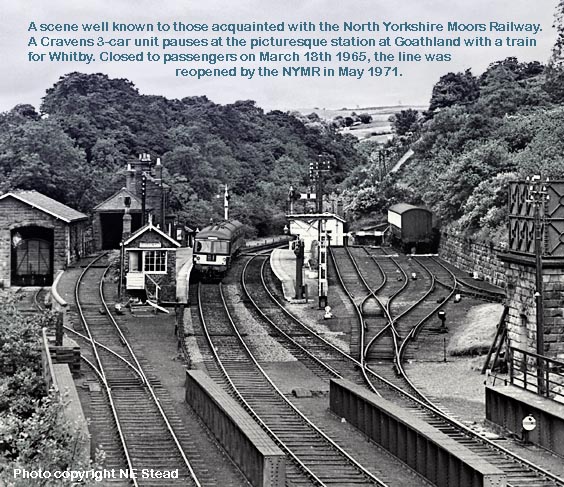
(Above-Below) Hitching a cab ride in August 1987, the contact sheet shows a driver's view of the route between Battersby and Whitby. (Below) Super-wide image of Whitby in 1987...click on photo once, then click again (not double-click) to see the full-sized image. A word of helpful advice when viewing these images. Press F11 on the keyboard to empty the screen of all extraneous clutter (tool bars top-bottom etc) revealing a full-size webpage on screen...it really does make a difference! After clicking on images to view super-wide size, move cursor off the image and right-click to return back to the page. You can press F11 on the keyboard at any time to return to the original screen.
(Below Left) Still going strong, a 3-car Metro-Cammell set skirts the River Esk on the final leg into Whitby in May 1982. (Below Right) By the end of the 1980s, the second generation dmus had taken over almost all rural rail services in the region. The twin railbuses built by W Alexander/A Barclay were designated Class 143 and made their debut in 1985. Here a pair of 2-car units forming the 07.23 Middlesborough-Whitby run alongside the River Esk on the final leg into Whitby in June 1987. The leading set is painted in the Tyne & Wear PTE's livery of yellow and white, whereas the trailing unit is finished in the Provincial Sector's two-tone blue livery. Sadly, the good looks of the new vehicles are let down by their solid interior bulkheads behind the driver's cab which denies passengers both front and rear views over some of the most picturesque lines which the railway companies are keen to promote.
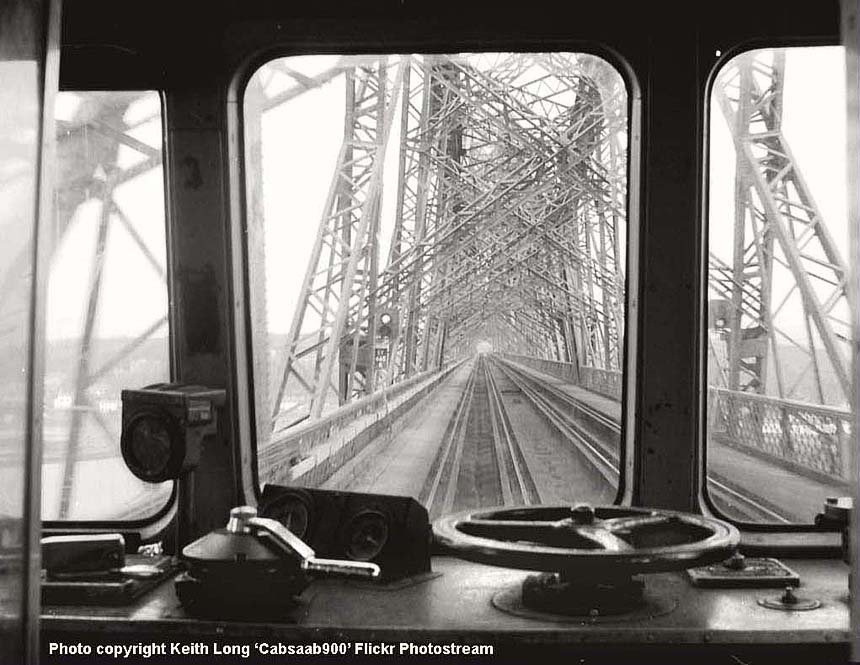
(Above-Below) Despite not liking the early dmu fleet (I was a staunch steam fan back in the 1960s) there's no denying the rickety-old First Generation vehicles had character - and, best of all, the view over the driver's shoulder was every spotter's dream! But as mentioned above, when the Second-Generation dmus were introduced the biggest disappointment was their solid interior bulkheads behind the driver's cab which denied passengers both front-rear views over some of the most picturesque lines in the country. I'm sure today's rail passengers would pay a premium to get a driver's eye view aboard a train crossing the Forth Bridge. (Above) This view from the cab of a dmu on Keith Long's excellent 'Cabsaab900' Flickr website here raises several comments from visitors to his site; Keith writes: 'A view unavailable today, as seen from a Class 101 crossing the Forth Bridge with the 10.50 Edinburgh-Kirkcaldy…' (Below) Keith took this shot of a Class 120 crossing the Forth Bridge with the 1513 Edinburgh Waverley to Cowdenbeath 1st June 1987.
PIONEER DIESEL RAILCARS
But I'm getting ahead of myself! We must go back to pre-BR days, when the former 'Big Four' railway companies began evaluating the efficiency of diesel railcar services on steam-hauled suburban trains and push-pull branch line stock. In 1938, the Derby Carriage & Wagon Works built a prototype 3-car articulated diesel unit, powered by 6 under-floor-mounted 125bhp Leyland diesel engines. Numbered 80000-80002 in the LMS fleet, the experimental vehicle entered service between Nottingham and London St Pancras, and Oxford and Cambridge. The LMS planned to build a production series based on the prototype, but this was cancelled at the outbreak of World war 2. This is such a shame! The vehicle had a very modern look, with a streamlined exterior, air operated sliding doors and air brakes - indeed, the LMS stock is not too far removed from the modern trains we see on our network today. The 3-car set is passing Blunham on the Oxford-Cambridge service on May 21st 1938. Photo RG Jarvis © Midland Railway Trust Ltd.
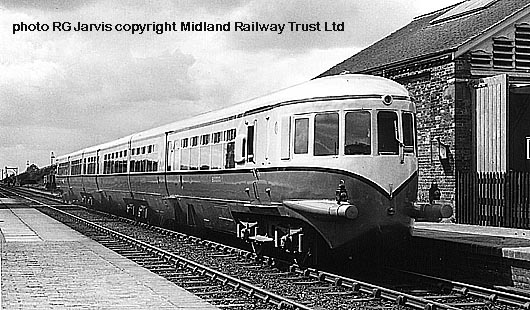
(Above) BR's new diesel multiple units were a direct descendant of earlier vehicles designed and built by the former 'Big Four' railway companies: LNER; LMSR; GWR and SR, which were amalgamated on January 1st 1948 to form the new British Railways. A total of 20,211 steam locomotives came into State ownership consisting of: 1,838 from the SR, 3,856 from the GWR, 6,525 from the LNER, and 7,805 from the 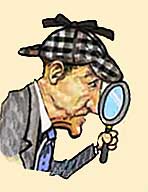 LMSR. The rest was made up of service engines and Departmental locomotives. BR also inherited a stock of 37 railcars comprised mainly of the wedge-shaped GWR AEC type single railcars and two surviving LNER vehicles.
LMSR. The rest was made up of service engines and Departmental locomotives. BR also inherited a stock of 37 railcars comprised mainly of the wedge-shaped GWR AEC type single railcars and two surviving LNER vehicles.
(Above-insets below) 'Investigative Research'. Since the Internet is a valuable resource used by serious students of railway history it is important to provide the correct information; some captions may require a high level of analytical research, and so my thanks to Vic Smith of York who has identified the above location as Kensington Olympia station. I subsequently checked the excellent 'Six Bells' website (click here) and assumed the railcar in my photo was the 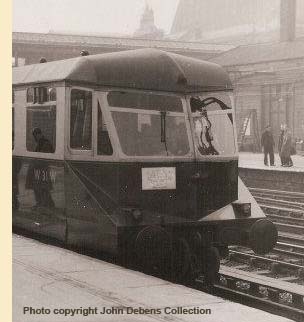 same W31W featured awaiting departure for Reading and Swindon on a railtour organized by Imperial College Railway Society City & Guilds Engineering & Works on 13th March 1955.
same W31W featured awaiting departure for Reading and Swindon on a railtour organized by Imperial College Railway Society City & Guilds Engineering & Works on 13th March 1955.
WRONG!
Vic writes - 'David, you have selected the wrong railtour; examination of the link reveals that the unit featured on the 'Six Bells' page has front window bars, no cab air vents and buffers.
Reference to the greatwestern.org.uk site indicates that the unit on your  page is in fact among the W5W-W17W range. The only railtour I can trace running from Kensington Olympia using a unit in that number series was W13W on 26th September 1954 by London Railway Society. A photo of this railtour at Olympia appears in Backtrack Volume 23 (2009). Best wishes, Vic Smith…'
page is in fact among the W5W-W17W range. The only railtour I can trace running from Kensington Olympia using a unit in that number series was W13W on 26th September 1954 by London Railway Society. A photo of this railtour at Olympia appears in Backtrack Volume 23 (2009). Best wishes, Vic Smith…'
Thanks Vic...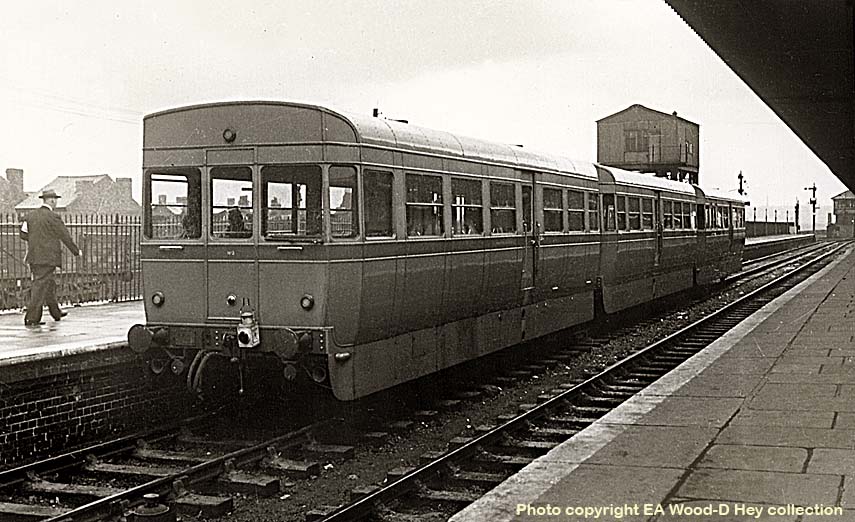

(Above-Below) This is an example of the later production ACV driving vehicles without brake accommodation No M79748 (seating 32 passngers) as seen with a broken cab window at Southall on 7th July 1957. A further four cars were built with brake accommodation and seating capacity for 45 passengers, plus four further unpowered intermediate trailers with seating for 52 passengers; a three-car set could therefore seat 129 whilst the two power cars could seat 77, about the same number as a conventional ten-compartment non-corridor coach. The production fleet appeared without skirting, presumeably to assist maintenance, and the vehicles were painted in BR green with straw lining, which became the standard livery for BR's multiple units to follow. The AEC's lightweight 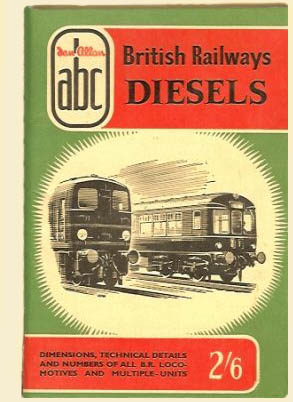 railbus saw experimental service as far afield as the Allhallows branch on the Southern Region and on the North Eastern Region's Market Weighton branch in the East Riding of Yorkshire. The whole fleet ended up on the LMR between 1955 and 1959, and after a brief period in storage the vehicles were cut up at Derby circa 1963. (Below) The prototype diesel railcar built by Associated Commercial Vehicles Ltd was powered by a 125bhp AEC bus type engine and underwent regional trials in 1953 before entering regular service on the Watford-St Albans line, and Harrow and Belmont branches. This experimental 3-coach 4-wheeled set was replaced by the more powerful 150bhp Park Royal 4-wheel single car railbuses in 1958 and finally scrapped in 1960. This photo could well be entitled 'dignity and impudence' as Class A3 60063 Pretty Polly simply dwarfs the lightweight 3-car set which at the time was undergoing trials on British Railways in 1953. Photo © BR Eastern Region.
railbus saw experimental service as far afield as the Allhallows branch on the Southern Region and on the North Eastern Region's Market Weighton branch in the East Riding of Yorkshire. The whole fleet ended up on the LMR between 1955 and 1959, and after a brief period in storage the vehicles were cut up at Derby circa 1963. (Below) The prototype diesel railcar built by Associated Commercial Vehicles Ltd was powered by a 125bhp AEC bus type engine and underwent regional trials in 1953 before entering regular service on the Watford-St Albans line, and Harrow and Belmont branches. This experimental 3-coach 4-wheeled set was replaced by the more powerful 150bhp Park Royal 4-wheel single car railbuses in 1958 and finally scrapped in 1960. This photo could well be entitled 'dignity and impudence' as Class A3 60063 Pretty Polly simply dwarfs the lightweight 3-car set which at the time was undergoing trials on British Railways in 1953. Photo © BR Eastern Region.

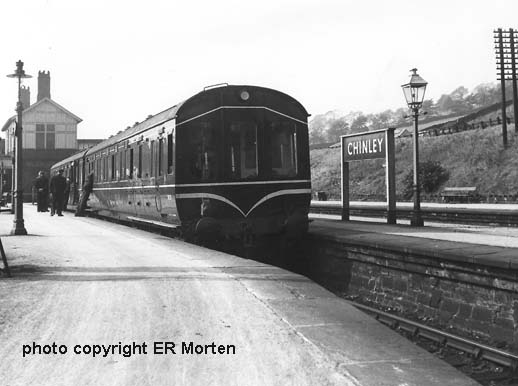
(Above-Below) On September 15th 1956, ER Morten photographed an experimental unit awaiting departure from Chinley's bay platform for its return run to the Derby Carriage & Wagon Works over the Peak Forest route. The two coaches - numbered M9821 and M9828 in the fleet - were converted from former LMS steam-hauled Open Brake Thirds, and the motor bogies were removed from withdrawn Euston-Watford electric units. The 2-car unit was powered by a Ruston-Paxman type 6ZHHL of 450bhp in each coach.
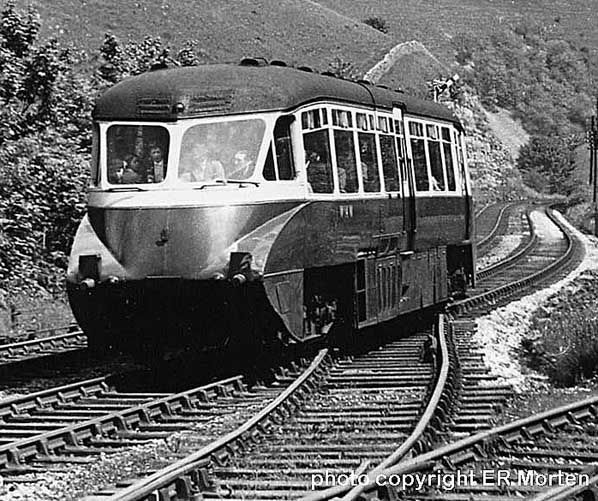
(Above) British Railways inherited several varieties of the wedge-shaped railcars built by AEC at Southhall to replace the old Churchward rail motors on local branch line services on the former GWR. The provision of a lavatory in some cars made them suitable for longer runs, though it was rare to find them working beyond the Western Region. I've heard of backseat drivers, but this is ridiculous! An AEC railcar No W14W is packed to the gills with members of the Birmingham Railway Club during their annual trip to Buxton via Ashbourne on 25th May 1952. The unit is passing Topley Pike signal box enroute to Buxton. Photo © ER Morten
BR 'DERBY LIGHTWEIGHTS'
I was converted to a DMU fan on my eigth birthday when my sister treated me to a ride on one of the new diesel units between Leeds Central and Harrogate in August 1954; she even splashed out on a couple of 1st-class tickets so that we could sit in the front compartment and get a driver's view of the line ahead.
However, being a staunch steam fan I stubbornly refused on the grounds that if we were going anywhere by train, then I preferred steam power any day of the week, but she argued that since the line between Leeds and Harrogate is heavily engineered (involving several viaducts and tunnels) getting a seat behind the driver was too good a chance to miss.
And she was right...train spotting had suddenly taken on a whole new meaning. The amply-glazed unit provided an excellent all-round view, both forward and aft, and it was possible to enjoy something of the fascination of railway operation - signalling, complicated junctions and steam engines in all their glory - a view previously seen by a few privileged first-class passengers in the luxurious tail-end observation cars during the 1930s. Okay, perhaps the new diesel multiple units could not match the standard of comfort and style to be found inside the Beaver Cars attached to the LNER's streamlined 'Coronation' express, but the unrestricted view of the road ahead was all I had imagined.
Above all else, it struck me how scary it was sitting at the front of a dmu without the protection of a steam boiler to cushion you in the event of a collision. As we swept through the murky depths of Bramhope Tunnel, we recoiled in our seats like disjointed test dummies, then after the obligatory stop at Arthington the dmu was galloping across Arthington Viaduct with its grandstand view of the Wharfe River and the rocky outcrop of Armscliffe Crag in the distance.
What a ride! My first trip in a diesel railcar left a lasting impression.
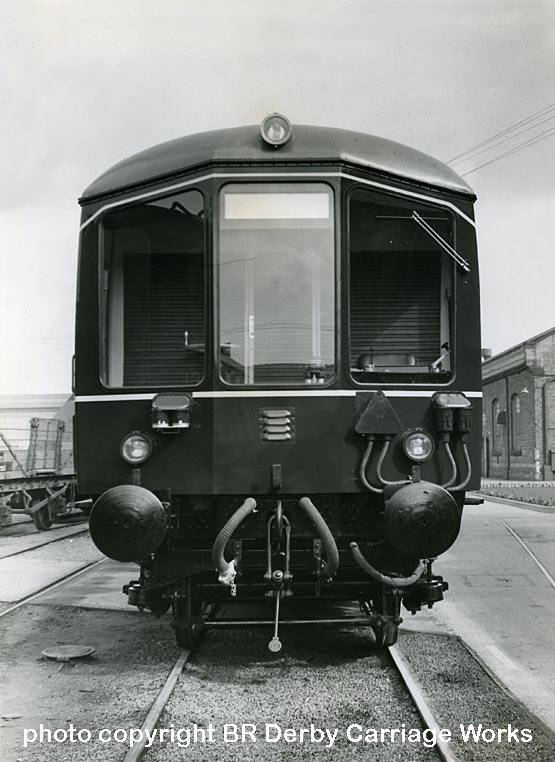
(Above-Below) The true forerunners of the first-generation diesel railcar fleet were the 'Derby Lightweights' (a nickname coined by the use of a light alloy and steel in their construction at the Derby Carriage & Wagon Works). The first BTC order was placed for eight 2-car sets for the West Riding service followed by an order for thirteen 2-car sets for West Cumberland. The West Riding sets No's 79000-79007 motor brake seconds and 79500-79507 motor composites were powered by two Leyland six-cylinder engines. The units made their debut on the service beween Leeds Central-Harrogate and Bradford Exchange in April 1954. A distinctive feature of the new railcars was their large front driving windows which gave excellent visibility for drivers - and passengers too, for that matter. Photos © BR Derby Carriage Works, BTC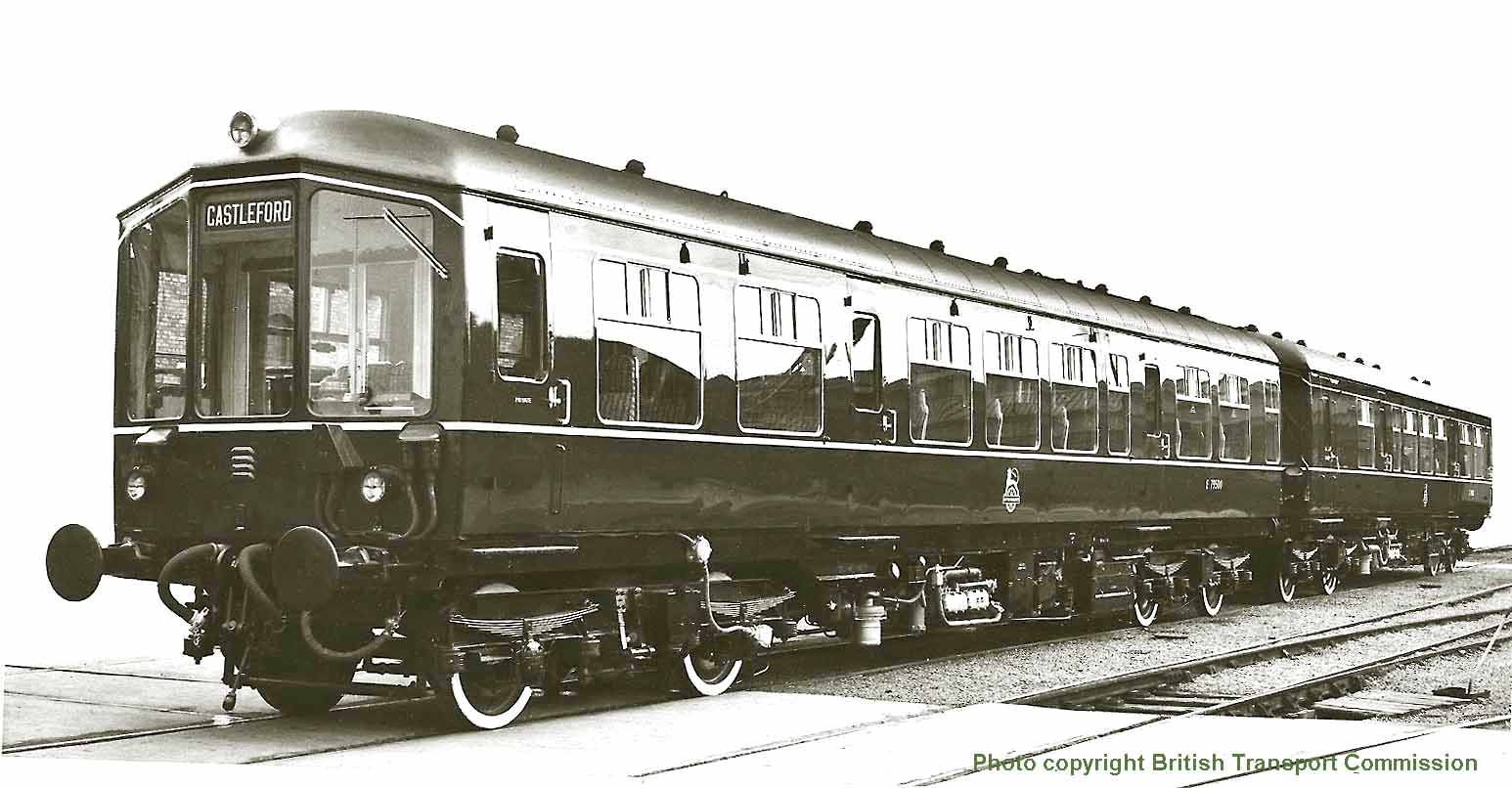
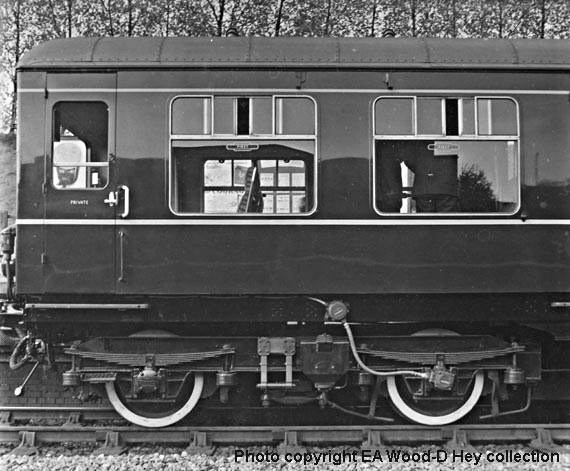
But not everyone in the steam spotting fraternity was impressed - a dmu in any shape and form served only to arouse their indignation. By the spring of 1955 the first railcars on the West Riding service were celebrating their first year in traffic, whilst the second batch (introduced on the Carlisle-Silloth service in November 1954) began operations on the Workington-Keswick-Penrith line, ousting in the process all of west Cumberland's steam-hauled local services. By the end of the year, the dmus had transformed the scene in Lincolnshire, working to Lincoln, New Holland, Skegness and Boston. They appeared in East Anglia working from Norwich to Ipswich, Yarmouth, Cromer, Sheringham and Lowestoft, and to Kings Lynn. On Teesside, new 4-car sets were introduced from Newcastle to Middlesbourough and Carlisle, and in the Midlands from Birmingham to Sutton Coalfield and Lichfield. This was followed by local services in North Wales, Lancashire and Derbyshire...by the end of the Fifties the diesel multiple units had spread like wildfire!
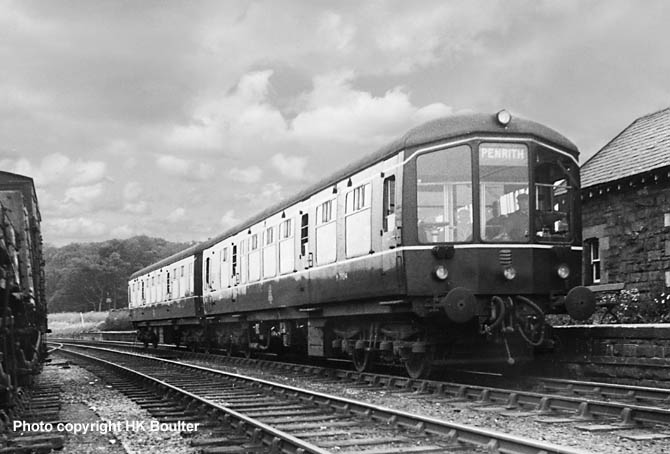
(Above-Below) Operating a batch of dmus on a rail network predominated by steam brought with it several problems. By its very nature, diesels require a clean working environment, therefore suitable premises had to be found for the stabling and maintenance of sets. The first vehicles for the West Riding services were allocated to the former GNR steam shed (Hammerton Street) in Bradford, and the West Cumberland pool was maintained at Carlisle Upperby carriage sheds and at Workington's steam shed 11B, where five tracks were partitioned off specifically for the purpose. A 2-car set stops at Penrudduck on 20th July 1955. (Below) Sporting front-end 'V' chevrons, or 'speed whiskers' as they became known, Nos M79639 and M79009 are seen at Carlisle M&C sidings on 10th September 1960. Note the bars on the drop light windows for working over the Maryport & Carlisle section which had limited clearance. Photos HK Boulter and DP Rowland. As a matter of interest, I've posted a couple of photos (real oldies!) of the Maryport & Carlisle Railway on the excellent Cumbria Railways website, including one shot that looks very like this spot.
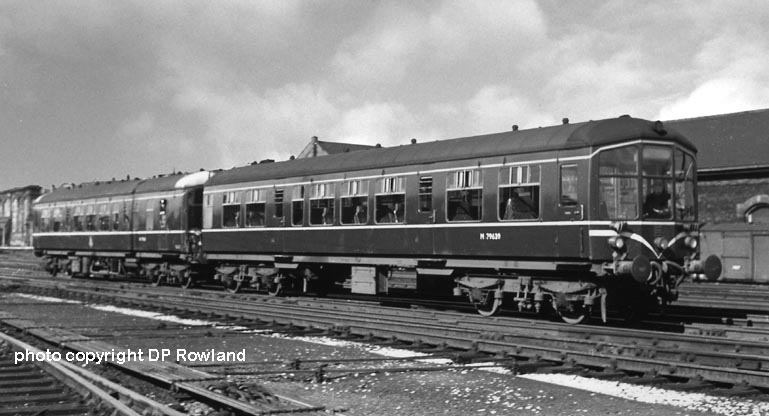

(Above-Below) The thirteen 'Derby Lightweights' destined for the West Cumberland service were powered by two BUT AEC 6-cylinder engines driving through a fluid flywheel and 4-speed epicycle box as used on the former GWR railways. One of the most scenic lines to found anywhere in Britain was the Cockermouth, Keswick and Penrith line. It was dieselised in February 1955, consisting of 8 trains daily in each direction. A 2-car unit awaits departure from Keswick on 17th July 1955. (Below) The 11.10 Carlisle-Penrith-Keswick-Workington pauses at Cockermouth on September 8th 1959. Photos © HK Boulter and IS Carr
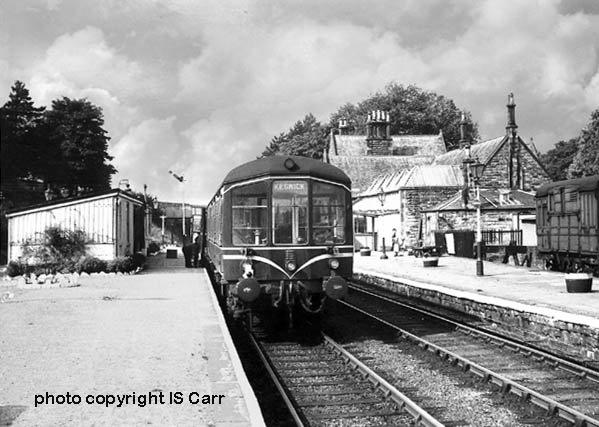
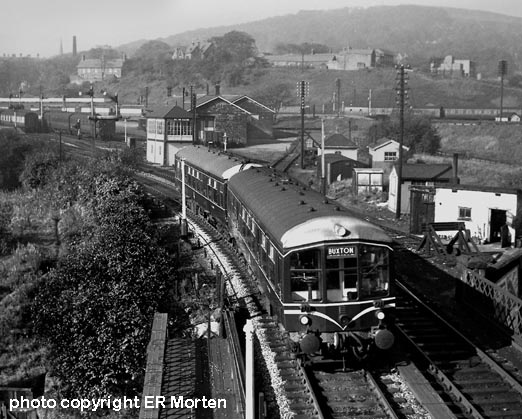
(Above) On the first day of the Buxton-Millers Dale diesel service, a 2-car set enters Buxton Midland station on October 14th 1956. The former LNWR terminus can be seen in the background, separated only by a roadway from the former Midland Railway station. Despite the fierce rivalry between the two companies the builders collaborated in building identical station facades, each incorporating a semi-circular window bearing the name of the owning company engraved in the stonework. Following closure of the MR station in 1968, the imposing facade was mindlessly reduced to rubble. Since then, fortune has dealt another blow to the area when Peak Rail abandoned the MR site and moved its operations to Matlock and Darley Dale - giving a direct link to the rail network. (Above Right) Travelling office! Photos © ER Morten.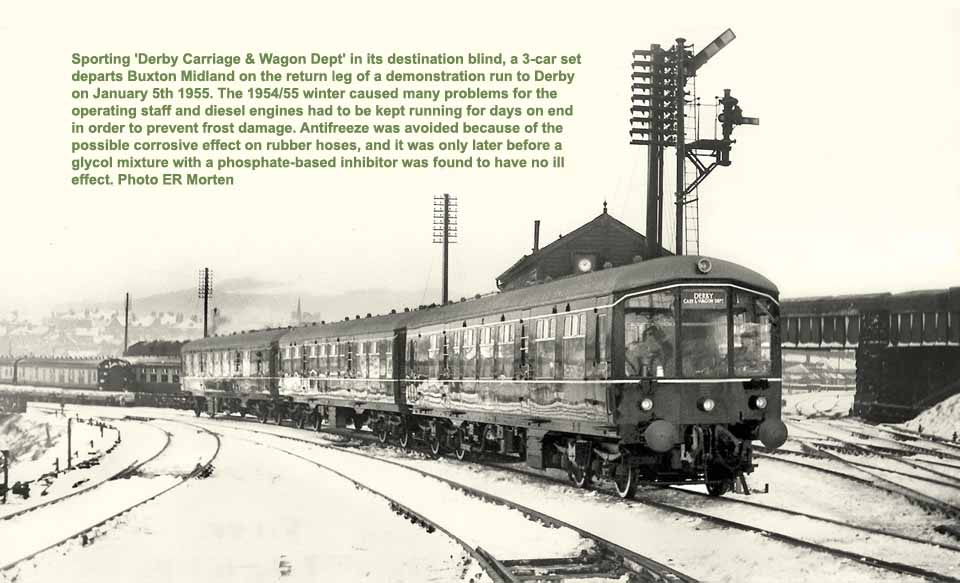
(Below) The Manchester (London Road) - Buxton diesel multiple unit service commenced on October 8th 1956, displacing the almost exclusive preserve of the Fowler 2-6-4T's based at Buxton steam shed. Here, No 42367 awaits departure from Buxton LNWR on 18th August 1951. The new dmus had to wait until 1957 before diesel facilities were constructed at Buxton, consisting of a main depot building with two tracks each 240ft long. In the second of ER Morten's photos, the destination blind shows Manchester London Road, as a 4-car set (now sporting a front-end chevron and white roof ends) heads past the proposed site on October 8th 1956.
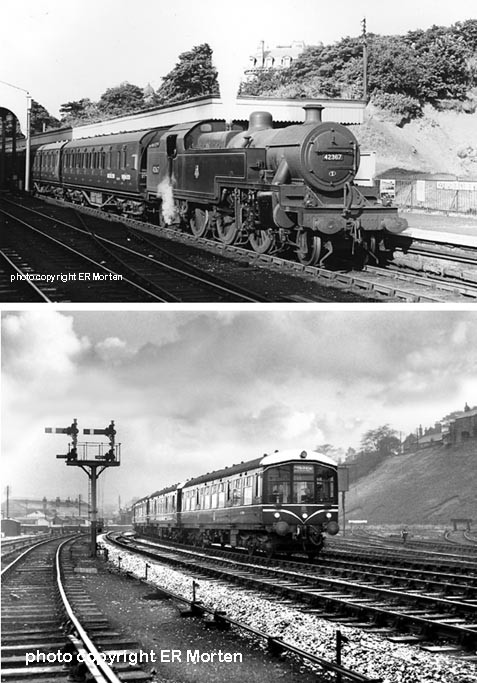

(Above-Inset Right) The Motor Brake Second single units built at BR Derby Works - numbered M79900-1 in the fleet - were introduced on the Buckingham to Banbury line, and Bletchley service on 13th August 1956. Here, single car No 79900 waits departure at Buckingham, which was an interchange point between steam 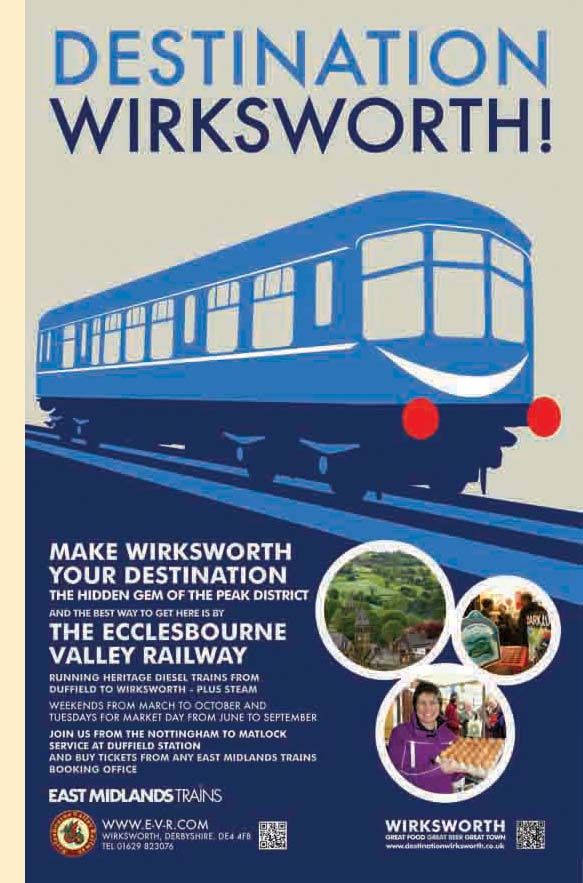 and diesel on local branch line services.
and diesel on local branch line services.
The photo prompted Neil Ferguson-Lee, Vice Chairman of WyvernRail plc to write - 'M79900 has enjoyed a charmed life since its days on the Banbury-Buckingham branch. Withdrawn from capital stock in 1968, the unit was renumbered TBD975010 and transferred to the BR Research Department. As Test Car 'Iris', the unit was used extensively over the whole network, supporting the development of radio communication systems.
Withdrawn in 1999, Iris was restored to original condition at Butterley and then moved to the Ecclesbourne Valley Railway (EVR) in 2008. - click here
As part of the EVR's extensive fleet of DMUs, Iris is employed regularly on passenger services between Wirksworth and Duffield and can be seen in operation most weekends between March and December. Iris has become the mascot of the Ecclesbourne Valley Railway and features prominently in the 'Destination Wirksworth' campaign. In addition to appearing on posters and publicity material, Iris even has a Facebook page: something that could never have been imagined when introduced nearly 60 years ago!'
Thanks for the information, Neil.  (Below) A 4-car 'Derby Lightweight' set departs from Betws-y-coed on a Llandudno-Blaenau Ffestiniog service. By this time, a 'V' chevron and white cab roof front ends have been added in an attempt to provide a visual warning for permanent way staff. Note the camping coach in the siding, much in demand for visitors to this beautiful part of the Conway Valley in North Wales. Photo © T Hancock
(Below) A 4-car 'Derby Lightweight' set departs from Betws-y-coed on a Llandudno-Blaenau Ffestiniog service. By this time, a 'V' chevron and white cab roof front ends have been added in an attempt to provide a visual warning for permanent way staff. Note the camping coach in the siding, much in demand for visitors to this beautiful part of the Conway Valley in North Wales. Photo © T Hancock
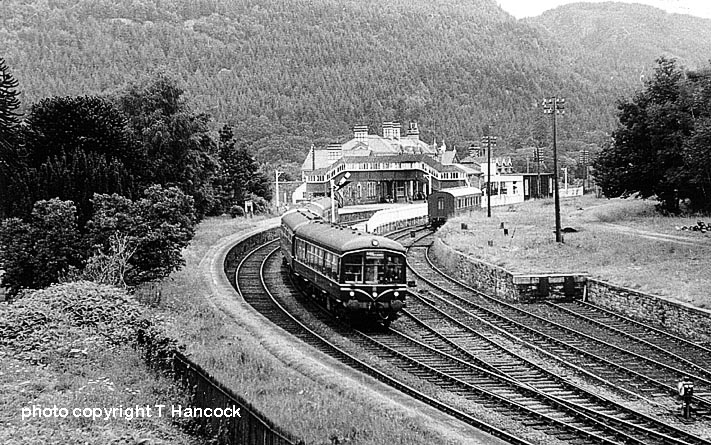
FIRST GENERATION DIESEL MULTIPLE UNITS
(Above-Below) The success of the Derby Lightweights saw the beginning of a new era for Britain's railways when finance was given to build a fleet of modern diesel railcars to replace uneconomical steam locomotive workings throughout the network. The BTC envisaged 3 types of railcar would be required to cover the various passenger services then to be found during the 1950's: branch line, local and suburban services and Inter-City services. Sadly, line closures were to outpace their introduction and the original plan for 4,600 vehicles was drastically cut to 3,810. The shot (above) shows a 3-car Metro-Cammell set approaching Horsforth on the Leeds Central-Harrogate service. (Below) The fifty 2-car sets constructed at BR Derby Works in 1956 represented the first vehicles in the Modernisation Plan. Numbered 50001-50049 DMBS and 56001-56049 DTL(L) in the dmu fleet, they were a lot heavier than the original Derby Lightweights, made up of a steel construction as opposed to the more expensive lighter-bodied vehicles. Here, a 4-car set forms an 'up' train near Peak Forest Junction on April 17th 1960. The amply-glazed dmu gave passengers an excellent all-round view of the scenery, which was particularly spectacular on the MR route. In the background is the aptly-named Great Rocks Dale. Photo © ER Morten
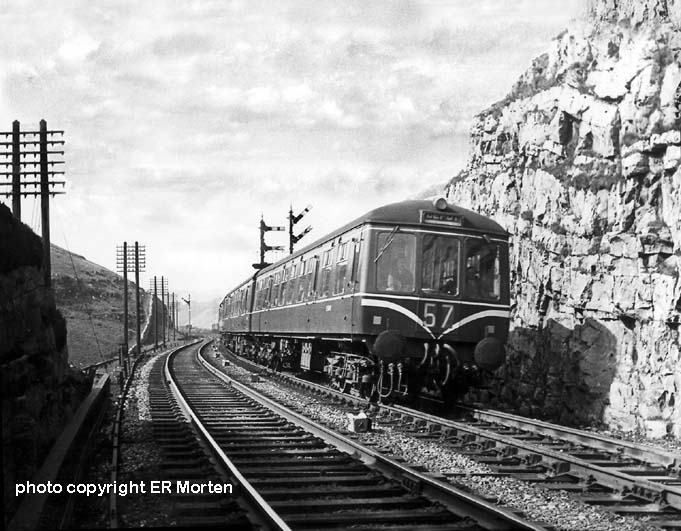
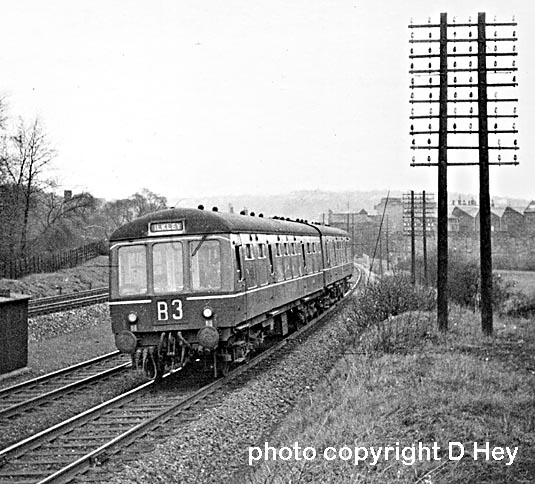
(Above-Below) In January 1959, all local trains between Leeds and Bradford to Ilkley and Skipton were dieselised, but despite the economies the new dmu service brought, closures could not be prevented. In 1965, seven intermediate stations were closed on the Aire Valley route between Leeds City and Bradford Forster Square. This Class 108 2-car set has just departed from the obligatory stop at Newlay & Horsforth station on the Leeds City-Ilkley service in September 1960. (Below) In the opposite direction, an Ilkley to Leeds service is made up of a 2-car set with additional rectangular yellow warning panels added to the cab front. Both Photos © D Hey
(Above-Below) Panoramic view of dmus in the upper Airedale between Keighley and Skipton...you may have to click this image twice to see the full size, depending on your size of monitor. (Below) With the distinctive visibility flash on their front ends, three sets of Metro-Cammells are seen at Darlington diesel depot on May 13th 1962. The addition of the 'V' warning flash has completely altered the front-end appearance, yet the Metro-Cammell style is quite unmistakable with the distinctive raked back fronts and the centre band of lining running between the bright aluminium windows on the bodyside. Later to become TOPS Class 101/102, the fleet was an amalgam of several batches of basically similar railcars ordered over a four year period. The modification included the provision of a roller blind route headcode panel beneath the cab windows. and on later batches a 4-panel type at roof level. The Metro-Cammells are joined by one of Cravens dmus with its distinctive two large front windows and destination blind fitted neatly at cantrail level.
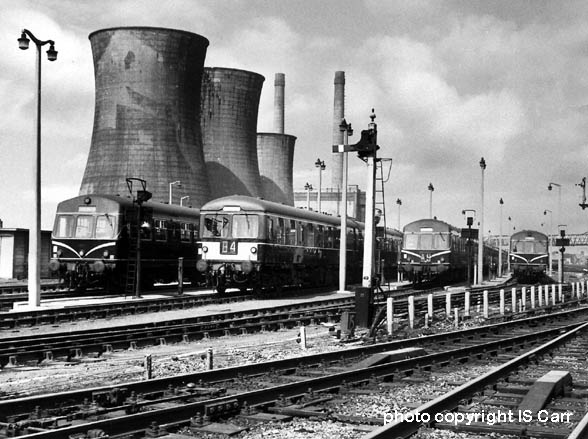
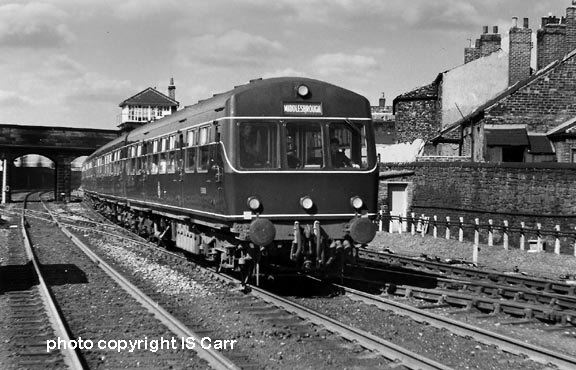
(Above) A four-car set forming a Newcastle-Middlesborough train approaches Monkwearmouth station in August 1958. The bodyside displays the original BR insignia consisting of a British lion embracing a flanged wheel.
(Below) A Scarborough-Hull dmu at Gristhorpe in the then East Riding of Yorkshire
(Below) The Sheffield-based company of Cravens Ltd built a total of 405 vehicles, including 278 powered vehicles, which entered service between 1956 and 1959. Although the Class 105 dmu was less numerous than their Met-Cam and Derby cousins, the Craven design is regarded as one of the classic dmus to appear in BR's first-generation fleet. The distinctive body design followed closely that of Mk1 coaching stock, using the same types of doors and windows - comparisons can be made with the Mk1 stock in the background - but the unmistakeable profile of the cab front (with two large windows in aluminium frames) and the upswept cantrail over the roof-mounted destination blind, was perhaps their distinguishing features. Here, comparisons with a Derby Class 127 set is recorded by rail cameraman Keith Long at Manchester Victoria on 4th June 1961
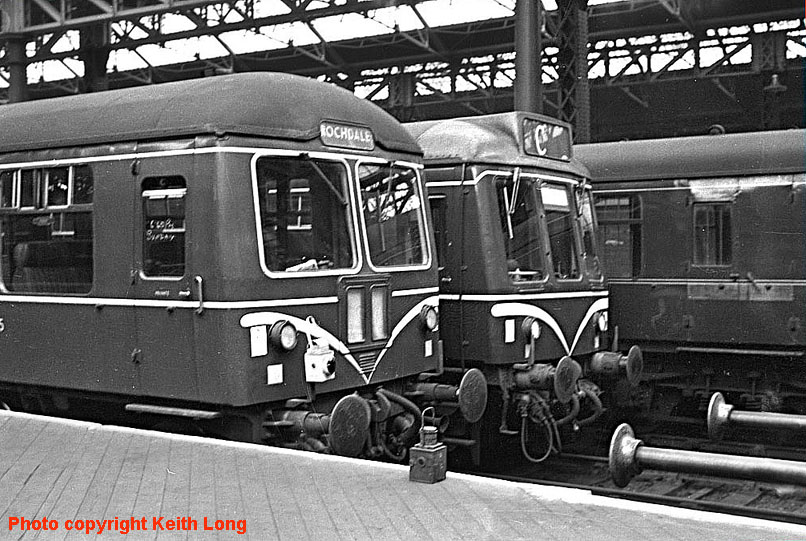
(Below) The Middleton-in-Teesdale branch was once dominated by NER Class A8 tanks before the introduction of Birmingham Railway Carriage & Wagon Co 3-car dmus (later TOPS Class 104) in 1960. A 3-car set awaits departure from the terminus on the Barnard Castle and Darlington service in June 1960. The Middleton-in-Teesdale branch diverged from the Penrith-Darlington line that ran via Kirby Stephen and Stainmore Summit across the Pennines.
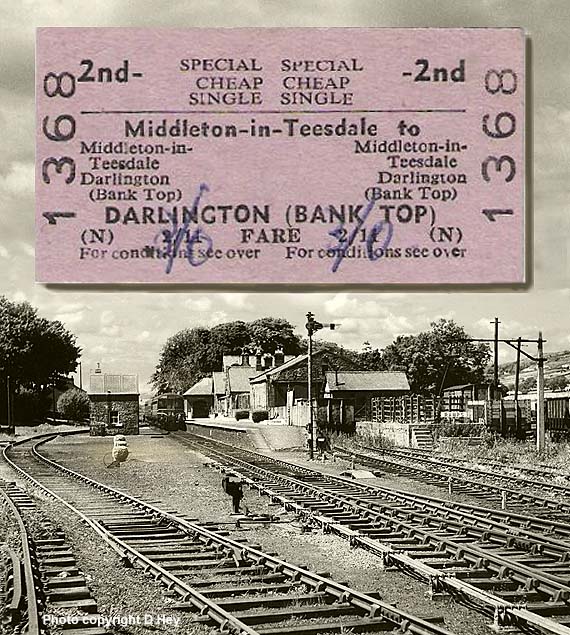
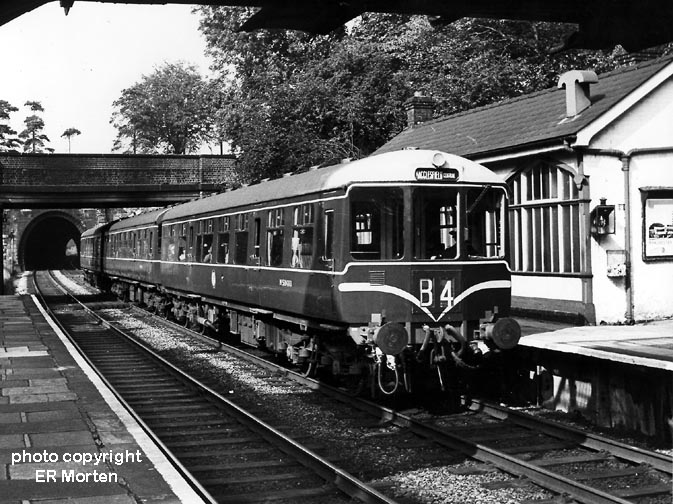
(Above-Below) Another Birmingham Railway Carriage & Wagon Co 3-car set is seen at Prestbury with a train for Macclesfield Central on August 6th 1960. Photo © ER Morten. (Below) A brief word about telegraph poles...I was recently contacted by rail enthusiast, Geoff Mawdsley, who has an interest in old telephones, switchboards, exchanges and railway communications, much of which has disappeared from the trackside over the past fifty years. Geoff writes - 'There is a site believe it or not, for people interested in old telegraph poles, and the chap who runs it posts pictures of poles with lots of arms on that you don't see now...I just love this quirky Click this link to the 'Telegraph Pole Appreciation Society'. here
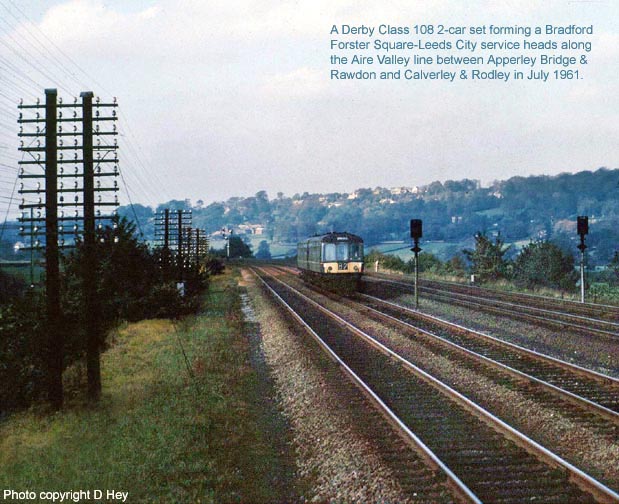
(Below) By the early Sixties the dmu programme was well advanced, but it would take a few years before the new stock was introduced in the Cumberland area. On August 14th 1963, intrepid railway photographer, Ian S Carr returned to the Lake District to update his collection with a shot of two early 'Derby Lightweights' standing side-by-side at Bassenthwaite Lake station, situated on the very shores of the lake (the main station building also functioned as a rural post office). The diesel units now carry a small rectangular warning panel and the yellow diamond coupling code symbol has been added above the buffer beams. The two platforms at Bassenthwaite Lake provided a passing loop for the single line section west of Keswick, but this fell victim to the Beeching axe on April 16th 1966, and the Penrith-Keswick line became a dead-end branch. In some cases, the Minister of Transport showed some leniency to curb the excesses of the Beeching Plan by approving only partial closure of a line, but it wasn't until the 1970s that we saw a more tolerant attitude towards socially useful lines. By then it was too late, because once the Genie was let out of the bottle, it could not be forced back in, as there was no machinery in place to reverse a closure notice which had already been approved by the Minister of Transport. So in spite of the savings from singling the line (and the replacement of the elderly 1955 units with modern Class 108 dmus in 1969) the reprieve for Keswick residents was short-lived and the Penrith-Keswick section finally gave way to closure on March 6th 1972. Photo © IS Carr
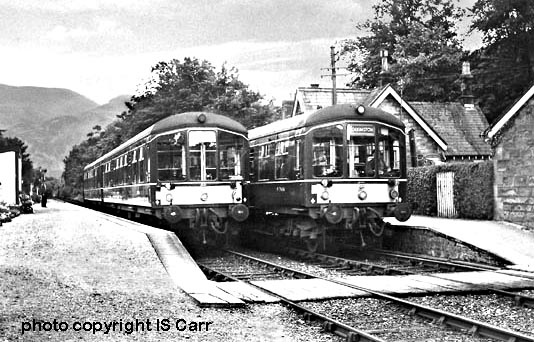
(Above) The basic premise of diesel multiple unit (dmu) operation is that the engines of several railcars can be coupled together to meet varying traffic needs, therefore the power available becomes proportional to the length of the train. However, as the new diesel programme progressed, different types of transmission were introduced and many of the first-generation dmus became incompatable and unable to work in multiple with each other. As a result, the control systems were colour-coded so that jumper leads could not be connected in error. In all, five transmission codes were introduced: Red Triangle, Yellow Diamond, White Circle, Orange Star, and Blue Square - the latter being the most common category covering 3,206 vehicles out of the fleet of 3,810 dmus. With the Blue Square symbol visible above the two buffers, a mixed combination of Derby and Metro-Cammell twin sets, make up a Harrogate-Leeds train near Wortley Junction. Photo © D Hey
(Below) Fast forward twenty-odd years, and we see a similar combination of both Derby and Metro-Cammell units emerging from Thackley Tunnel on the Skipton-Leeds service in July 1981. By this time, the first generation dmus (built to designs conceived during the 1950s) were well past their best, yet they continued to put in sterling service. In 1975 BR introduced a refurbishing programme, including repainting, improved heating and ventilation, soundproofing and general improvements to the interior. The treatment may well have been tangible proof of the worthiness of the old stock, yet it served to underline the need for more modern vehicles. In 1984, BR embarked on a programme of almost total replacement of its existing fleet, with the introduction of the second-generation dmus, including the new Class 14X 'Pacer' and Class 15X 'Sprinter' types. Photo © D Hey
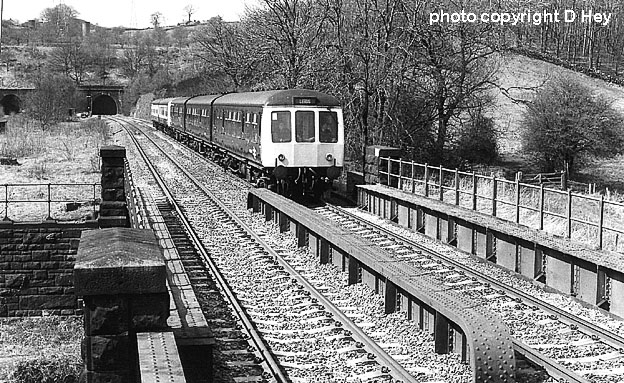
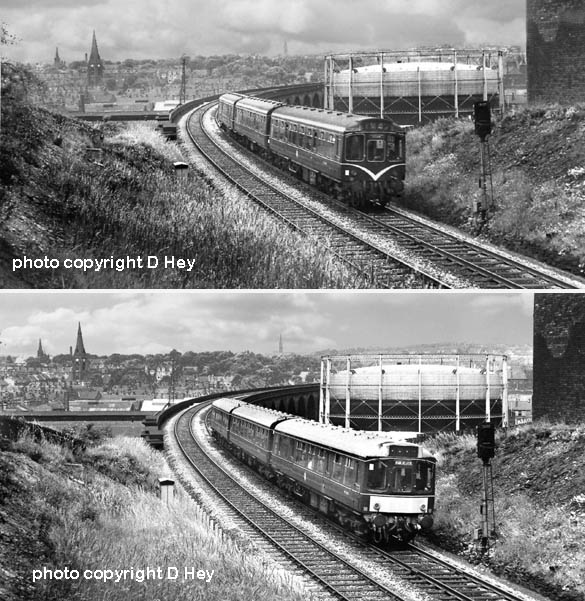
(Above-Below) Introduced in 1960, the Birmingham Railway & Carriage Co (TOPS Class 110) dmus were built for the steeply graded Calder Valley line across the Pennines. The 3-car sets were powered by two 6-cylinder engines in order to gain the additional horsepower necessary to maintain the tight point-to-point schedules. By January 1962, the Leeds-Bradford-Manchester route was served by an hourly service with some trains running throughout between Harrogate and Liverpool. Sporting its original livery with 'speed whiskers' on the front end, a Harrogate-Liverpool 3-car unit crosses Kirkstall Viaduct, Leeds on 27 July 1961. A prominent feature of the BRCW dmus was their 4-panel route indicator boxes moulded as an integral part of the glass fibre roof canopy. Here the destination blind displays Manchester, as a 3-car unit (now adorned with white roof and rectangular yellow warning panel) passes the same spot in July 1962. (Below) A 6-car set for Liverpool Exchange emerges from Bramhope Tunnel in June 1962. All: © D Hey
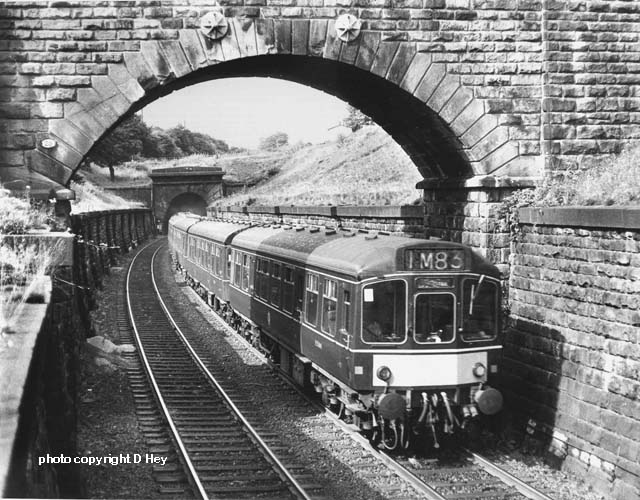
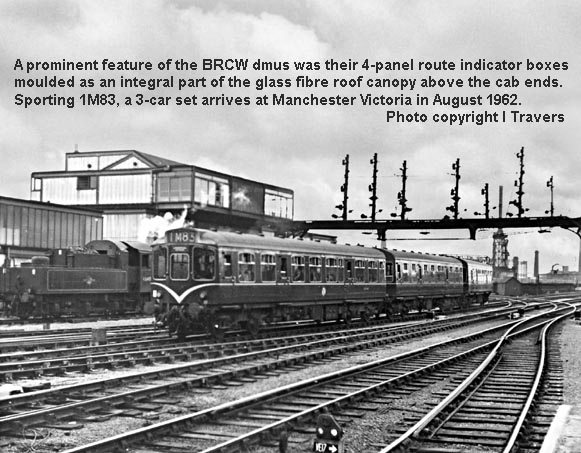
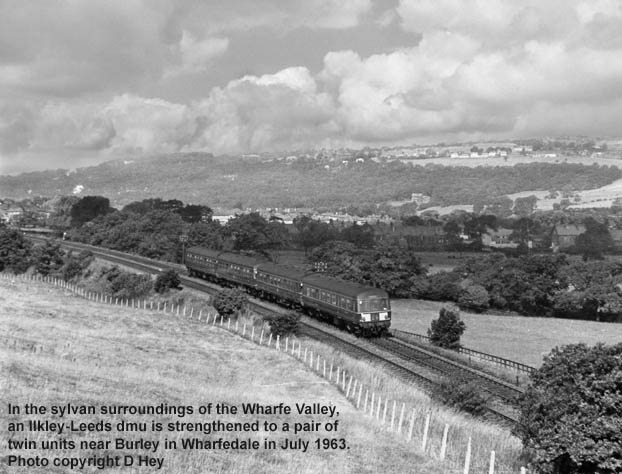
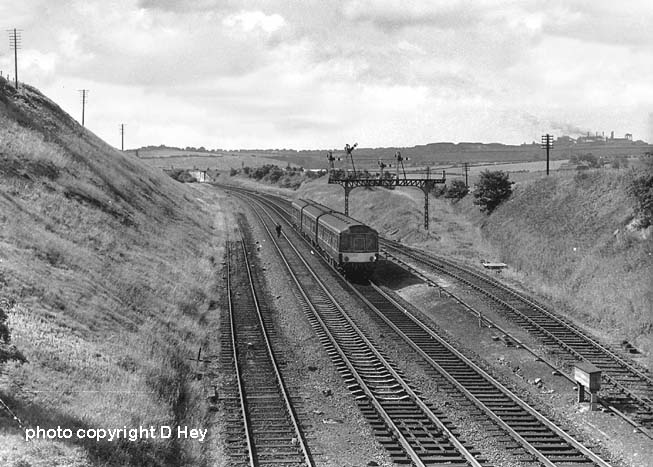
(Above) Off the beaten track! A 3-car Calder Valley set passes Beeston Junction heading towards Leeds in August 1963. The weed-ridden track on either side of the main line was once the start the fly-over junction for the Batley branch which closed in 1951.
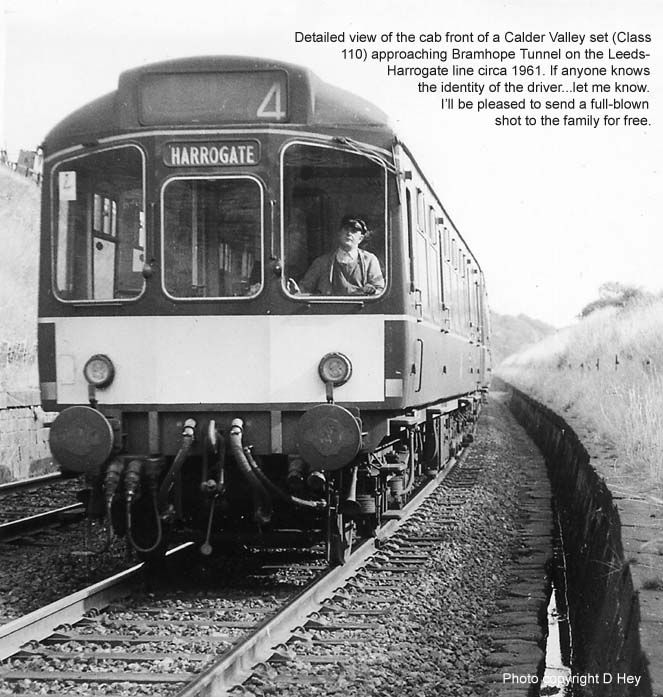
(Below) The Swindon-built Trans-Pennine (TOPS Class 124) InterCity units were a stylish addition to the BR fleet. The service began on January 2nd 1961 between Hull and Liverpool, with 6 trains each way daily via the Standedge route. Their power/weight ratio made possible substantial acceleration of the Trans-Pennine service, though this Hull-bound set will struggle to keep to time having been held at signals due to snow clearing operations during the artic winter in January 1963. Photo © JR Carter.
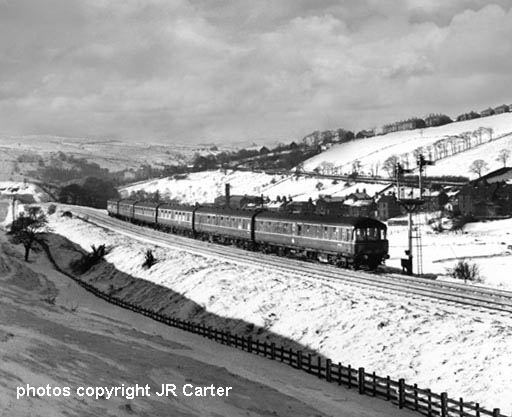
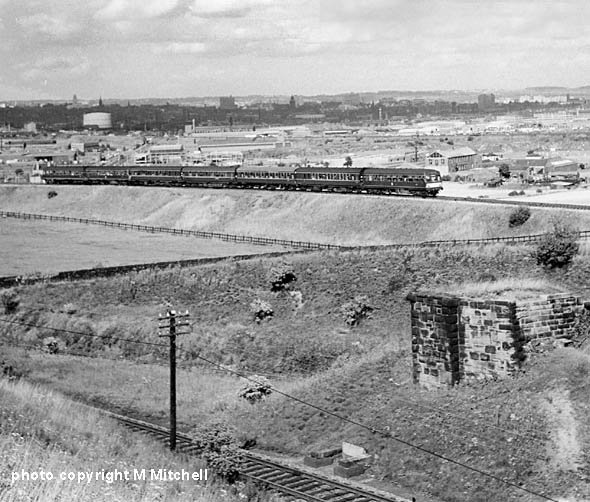
(Above) The introduction of the Inter-City Trans-Pennine units (the 'Intercity' name was hyphenated in those days) between Hull and Liverpool gave the Trans-Pennine route a new lease of life. The Swindon-built 6-car sets (including a griddle car) had four power cars fitted with Leyland Albion 230hp engines, which provided a formidable 1,840 horse power for the steeply-graded route across the Pennines. The fleet was relatively trouble free, except for a period during 1964 when a number of failures occurred on the powered vehicles. As a consequence, several units lost their driving motor composites which were substituted by a twin dmu set, or a single Metro-Cammell gangwayed to the rest of the train. Here, the 3-45pm Leeds-Liverpool is made up of a mishmash of 7 cars, and is seen climbing the 1 in 52 gradient from the flyover junction at Farnley, Leeds on 29 August 1964. Photo © M Mitchell
(Below) The 6-car Trans-Pennine units were allocated to Neville Hill brand new, but spent the remainder of the working lives at Hull Botanic Gardens. A total running time of 163 minutes was introduced on the 127.7 mile route between Hull and Liverpool - an average speed of 47mph, including stops at Brough, Selby, Leeds, Huddersfield, Manchester and Earlstown Junction. The cross-country service was switched to the steeply-graded Heckmondwike-loop line between Leeds and Huddersfield, which involved a climb of 3½ miles at 1in 70 through Gildersome Tunnel. Here, the 12.10pm Hull-Liverpool climbs to the summit at Birstall on 16 July 1963. Photo © M Mitchell
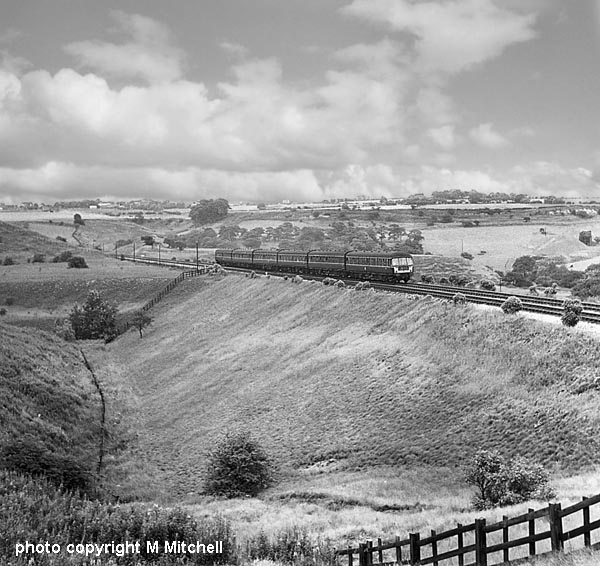
(Below) As for the changeover to WR dmu services? With the rank and file of steam classes in rapid decline, it became increasingly difficult for the operating department to find a suitable steam locomotive with a power classification relative to its train formation; either being too heavy or too light for the purpose. The diesel multiple units offered a practical solution to this problem as the engines of several railcars could be coupled together to meet varying traffic needs, therefore the power available became proportional to the length of the train. In the case of the Swindon-built Class 126s, however, pragmatism - rather than aesthetics - was the main item on the agenda, for the 70mph Inter-city units were not the best looking vehicles. Powered by two AEC 150hp engines, the 3-car sets had two front ends - a full-width cab and a half-cab incorporating a central gangway connection which allowed through access within a 6-car set. Prior to commencing service in Scotland, the first six 3-car sets were introduced on the WR's Birmingham-Cardiff-Swansea service in June 1957, the usual formation being comprised of six cars with the two gangwayed trailers coupled together in the centre of the train. Sporting a 'V' chevron on the front-end, a 3-car set arrives at Gloucester. Photo © EA Wood collection.
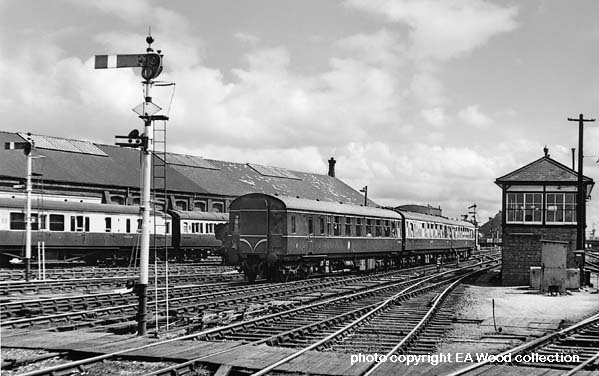
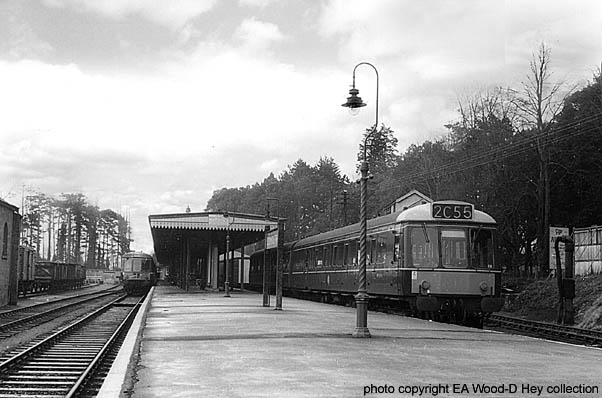
(Above) Despite the economies the new dmus brought, many branch line closures could not be prevented. This included the former LSW's Sidmouth branch on the Devon coast which was dieselised in November 1963, but succumbed to the Beeching axe in March 1967. Here a pair of Derby Class 108 dmus occupy the single platform - the one on the left retains its 2-character train description panel beneath the driving cab windows and a small destination panel in the cab roof, whilst the newer vehicle from 1960 onwards (right) has been modified with a 4-panel route indicator box moulded as an integral part of the roof canopy and the destination panel relocated aboye the central cab window. Here the 4-character train description blind displays 2C55, as a 2-car unit - sporting a white cab roof - awaits departure in May 1964. Photo © EA Wood collection.
(Above-Inset-Below) Following the introduction of the Hendon-Glasgow 'Condor' freight service and the commencement of the Midland Pullman on July 4th 1960, the blue riband for the fastest freight and passenger train went to the London Midland Region's Central Line. As it turned out, the Midland Pullman was not far removed from the HST consisting of two six-coach sets with streamlined power cars, two kitchen cars and two parlour cars, providing 132 1st class seats. Surprisingly, the traditional umber and cream livery of previous Pullman stock was not adopted. Instead, the new Pullman was painted in a striking Nanking blue and white livery with the fine fuedal Pullman coat of arms applied to the nose ends. The luxury trains were air-conditioned, sound proofed and thermally insulated, with double glazed windows and wall-to-wall carpeting in the traditional Pullman style of open saloons, which included airline-style seats and fixed tables. (Above) This stylish British Railways (London Midland Region) poster - 'Express Success  - Midland Pullman' - was painted by artist unknown and printed by Sanders Phillips & Co Ltd, London. The stunning images from the NMSI collection show the quality of poster art to be seen on station platforms across the country during the 1950-60s. For the record, the NMSI family is comprised of four award-winning museums, each with their own diverse identity: the Science Museum, the National Media Museum and, of course, the National Railway Museum (NRM) at York which houses the world's pre-eminent railway collection. The NMSI Online is a superb website containing countless thousands of objects including a range of fabulous railway travel posters...a visit is highly recommended. (Inset Left) Mention is made on this site about the wonderful artwork created by Arthur Nigel Wolstenholme, a freelance technical and commercial artist,who initialled his drawings tantalisingly ANW. Mister Wolstenhome is perhaps most famous for producing crisp, high quality illustrations of steam and diesel locomotives for the covers of Ian Allan's famous abc Locospotter Books. This original artwork features a Blue Pullman, which Mister Wolstenholme produced for use in Western Region advertisements promoting the new South Wales Pullman service. The artwork measuring 13½" x11½" sold for £320 at a Great Central Railwyana Auction in October 2011. (Below) The prestigious Midland Pullman service left Manchester Central at 8.50 and completed the 190 miles to St Pancras in 194 minutes, including a stop at Cheadle Heath. On the first day of service the 'up' train passes Great Rocks Junction on July 4th 1960.
- Midland Pullman' - was painted by artist unknown and printed by Sanders Phillips & Co Ltd, London. The stunning images from the NMSI collection show the quality of poster art to be seen on station platforms across the country during the 1950-60s. For the record, the NMSI family is comprised of four award-winning museums, each with their own diverse identity: the Science Museum, the National Media Museum and, of course, the National Railway Museum (NRM) at York which houses the world's pre-eminent railway collection. The NMSI Online is a superb website containing countless thousands of objects including a range of fabulous railway travel posters...a visit is highly recommended. (Inset Left) Mention is made on this site about the wonderful artwork created by Arthur Nigel Wolstenholme, a freelance technical and commercial artist,who initialled his drawings tantalisingly ANW. Mister Wolstenhome is perhaps most famous for producing crisp, high quality illustrations of steam and diesel locomotives for the covers of Ian Allan's famous abc Locospotter Books. This original artwork features a Blue Pullman, which Mister Wolstenholme produced for use in Western Region advertisements promoting the new South Wales Pullman service. The artwork measuring 13½" x11½" sold for £320 at a Great Central Railwyana Auction in October 2011. (Below) The prestigious Midland Pullman service left Manchester Central at 8.50 and completed the 190 miles to St Pancras in 194 minutes, including a stop at Cheadle Heath. On the first day of service the 'up' train passes Great Rocks Junction on July 4th 1960.
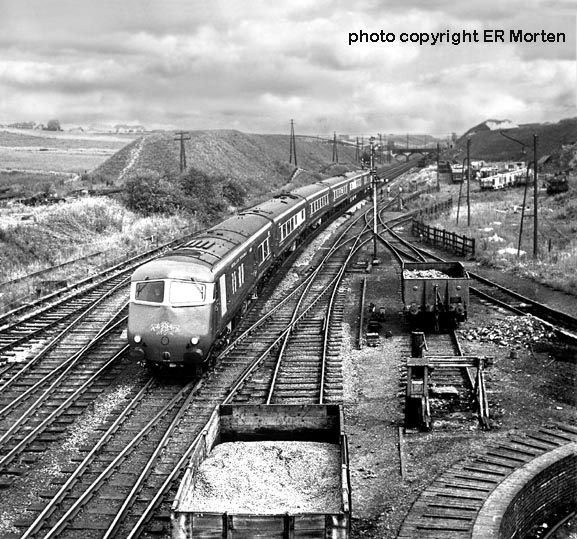
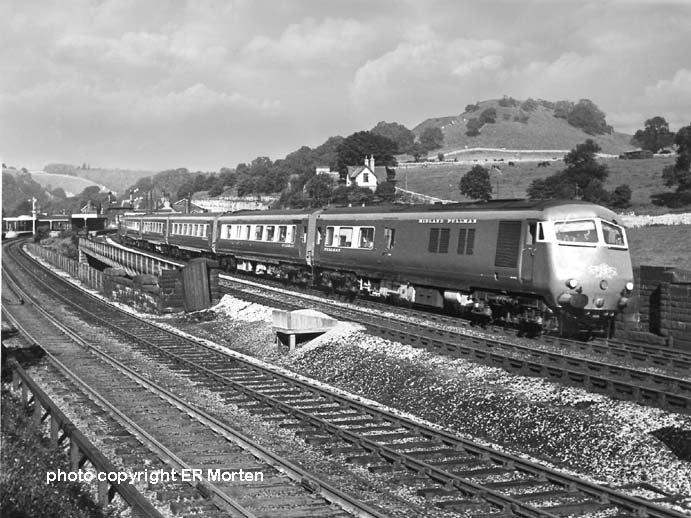
(Above) Following completion of WCML electrification, an entirely new passenger service came into operation between Manchester Picadilly and Euston - the fastest train taking only 2hrs 35 minutes for the 189 miles at an average speed of 73mph. By March 1967 the Midland Pullman was rendered surplus to requirments and the two 6-car sets joined the Western Region's three 8-car sets for use on the Paddington-Bristol and Paddington-Wolverhampton routes. With the sun-visor fully extended, the 'up' train makes a fine sight sweeping through Millers Dale station in August 1961.
Please note: in order to maximise webspace the photos featured in the DMU Gallery 1980s - 'Still Going Strong!' have been moved to a page of their own. A link is provided here.
Polite notice: All text and photographs are protected by copyright and reproduction is prohibited without the prior consent of the © owners. If you wish to discuss using the contents of this page the email address is below. Please note - this is not a 'clickable mail-to link via Outlook Express:
dheycollection@ntlworld.com
